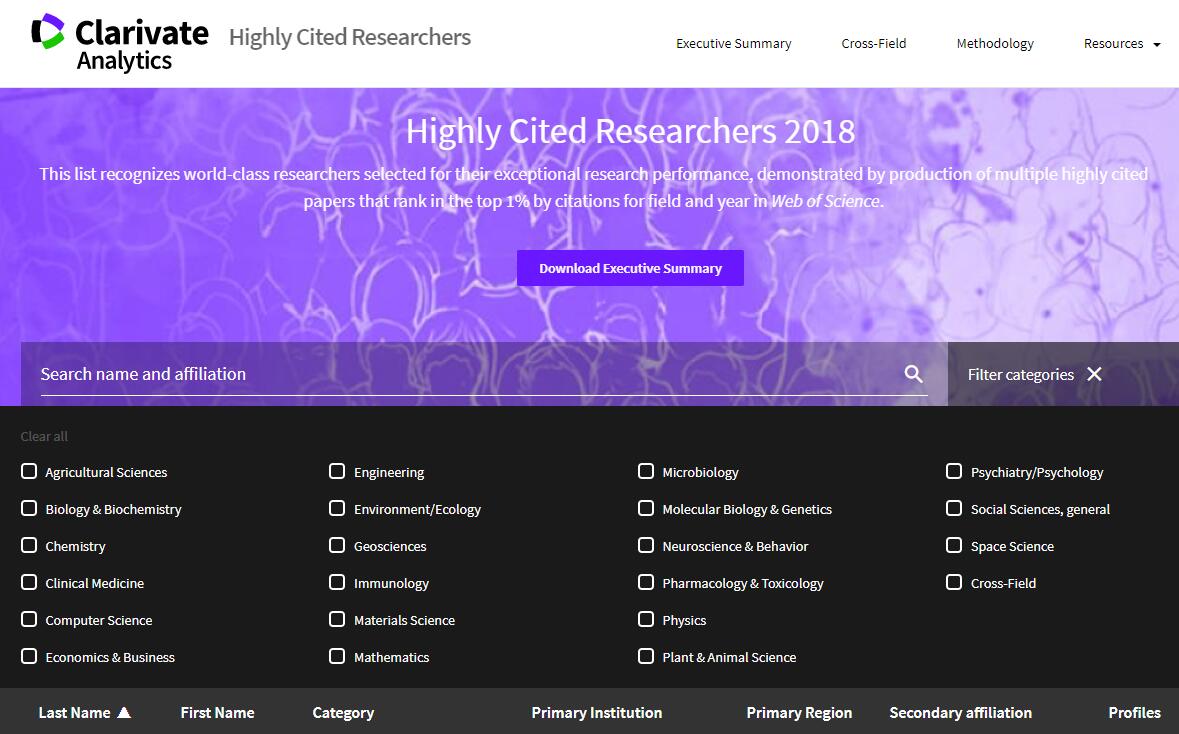博文
2018高被引学者分布领域知多少!
|
11月27日,科睿唯安(clarivate)网站公布了2018年高被引学者(Highly Cited Researchers)名单!本榜单是通过对21个大学科领域和交叉学科领域的过去10年内(2006-2016)被SCI收录的自然和社会科学领域论文进行分析评估,并将所属领域同一年度他引频次在前1%的论文进行排名统计后得出的。2018年名单中共有6078名高被引学者,分布在22个学科领域当中,其中与生命科学相关的学科领域占据了12个。

6078名高引学者在各个学科中的分布情况如下:农业科学(Agricultural Sciences)158名,生物学和生物化学(Biology & Biochemistry)254名,化学(Chemistry)261名,临床医学(Clinical Medicine)487名,环境科学和生态学(Environment/Ecology)185名,免疫学(Immunology)146名,微生物学(Microbiology)148名,分子生物学和遗传学(Molecular Biology & Genetics)248名,神经科学与行为学(Neuroscience & Behavior)197名,药理学和毒理学(Pharmacology & Toxicology)161名,植物学和动物学(Plant & Animal Science)223名,心理学和精神病学(Psychiatry/Psychology)157名,计算机科学(Computer Science)96名,经济和商业(Economics & Business)96名,工程学(Engineering)214名,地球科学(Geosciences)184名,材料科学(Materials Science)208名,数学(Mathematics)90名,物理学(Physics)211名,社会科学总论(Social Sciences, general)211名,空间科学(Space Science)122名,交叉学科(Cross-Field)2019名。

从以上数据可看出,3959名高被引学者分布在21个相关领域,而另2019人全部为交叉学科,这也可看出不同学科之间的交叉研究越来越多,反映了当前的研究趋势,比如我校共有10名学者入选为2018年高引学者,其中6名属于交叉学科领域,其他4名分别属于计算机科学(3名)和材料科学。
Clarivate 网站关于2018年高引学者的介绍如下:
The Highly Cited Researchers list from Clarivate Analytics identifies scientists and social scientists who have demonstrated significant influence through publication of multiple highly cited papers during the last decade.
Researchers are selected for their exceptional performance in one or more of 21 fields (those used in Clarivate Analytics Essential Science Indicators, or ESI) or across several fields.
Approximately 6,000 researchers are named Highly Cited Researchers in 2018 – some 4,000 in specific fields and about 2,000 for cross-field performance. This is the first year that researchers with cross-field impact are identified.
The number of researchers selected in each field is based on the square root of the population of authors listed on the field’s highly cited papers. The number of those with cross-field influence is determined by finding those who have influence equivalent to those identified in the 21 fields.
For the 2018 Highly Cited Researchers analysis, the papers surveyed were published and cited during 2006-2016 and which then ranked in the top 1% by citations for their ESI field and year (the definition of a highly cited paper).
The threshold number of highly cited papers for selection differs by field, with Clinical Medicine requiring the most and Agricultural Sciences, Economics & Business, and Pharmacology & Toxicology the least.
A second criterion for selection is a citation count to highly cited papers that ranks a researcher in the top 1% by citations in an ESI field for the period surveyed.
To identify researchers with cross-field impact, highly cited paper and citation counts are normalized through fractionating according to the thresholds required for each field (thus, each Clinical Medicine paper, has a smaller unit fraction than one in Agricultural Sciences). Citations counts are fractionated in a similar manner. If the sum of the publication counts and the sum of the citation counts for a researcher equals 1.0 or more, the individual exhibits influence equivalent to a researcher selected in one or more ESI defined fields and is therefore selected as a Highly Cited Researcher for exceptional cross-field performance.
There is no unique or universally agreed concept of what constitutes exceptional research performance and elite status in the sciences and social sciences. Consequently, no quantitative indicators will point to a list that satisfies all expectations or requirements. Moreover, a different basis or formula for selection could generate a different – though likely overlapping – list of names. Thus, the absence of a name on our list cannot be interpreted as inferior performance or stature in comparison to those selected. To understand both the meaning and the inevitable limitations of our analytical approach, a careful reading of the methodology is required.
https://blog.sciencenet.cn/blog-3319332-1148856.html
上一篇:20181128——肉穗草(Sarcopyramis bodinieri Levl. et. Van.)
下一篇:20181129——偏瓣花(Plagiopetalum esquirolii (Levl.) Rehd.)